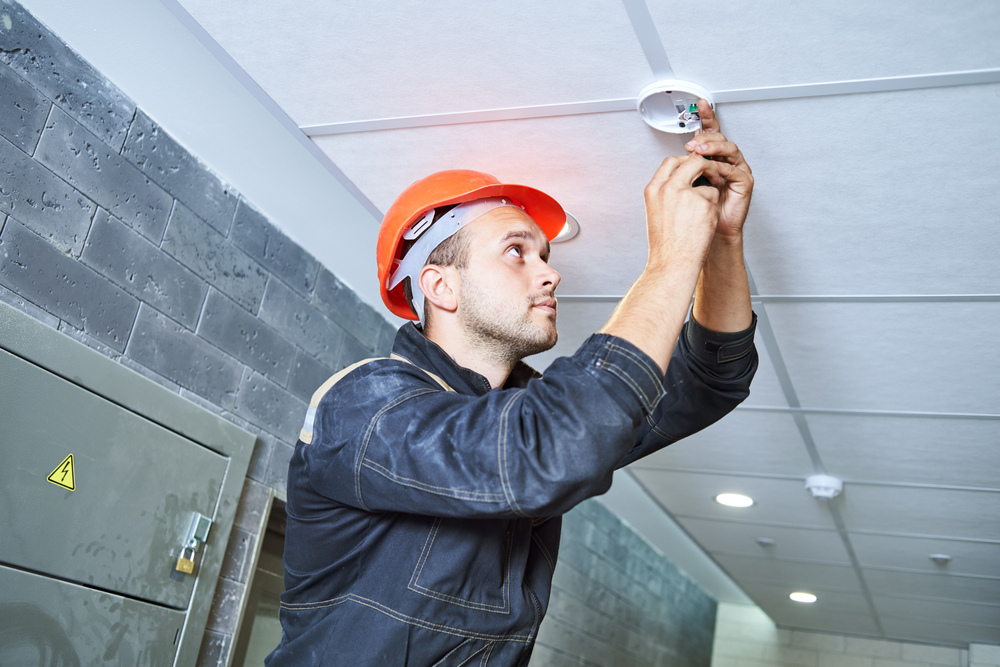 22
Oct
22
Oct
A Step-By-Step Guide To Fire Alarm Installation
- 0 Comment(s)
- October 22, 2024
Installing a reliable fire alarm system is crucial for protecting lives and property from the threat of fire. Whether you’re setting up a system in a small business or a large commercial building, ensuring proper fire alarm installation is key to early detection and swift response in the event of a fire.
This step-by-step guide will walk you through the essential considerations and stages of installing a fire alarm system, helping you create a safer environment while adhering to fire safety regulations.
Step 1: Selecting the Right Fire Alarm System
Choosing the right fire alarm system is the first step in ensuring successful installation. Not all fire alarms are the same, and the best system for your space will depend on its size, layout, and usage. There are two main categories to consider when selecting a system:
- Wireless vs. Hard-Wired Systems: Wireless systems are easy to install and flexible, making them suitable for smaller spaces or buildings where wiring may be challenging. On the other hand, hard-wired systems are more reliable, drawing power directly from the building’s electrical supply with battery backups to ensure functionality even during power outages. For residential homes or smaller buildings, wireless systems might suffice, but larger spaces like commercial facilities benefit from the dependability of hard-wired systems.
- Addressable vs. Conventional Systems: Addressable fire alarm systems are more advanced and provide specific information about the location of the fire within the building. This feature makes them ideal for larger buildings or businesses requiring precision during emergencies. Conventional systems, in contrast, are more suitable for smaller spaces where a general alarm will suffice without location specificity.
By carefully evaluating the size and complexity of your building, you can select the system that best meets your needs.
Step 2: Planning the Fire Alarm Layout
Once the fire alarm system is chosen, the next step is planning the layout of the devices. This involves determining where to place the alarms and other fire detection components for maximum safety and compliance with fire safety regulations. The layout is influenced by several factors, including the size of the building, its purpose, and the local fire codes.
For example, fire alarms should be placed:
- On every floor of the building.
- In critical areas such as kitchens, stairways, hallways, and bedrooms for residential homes.
- Near high-risk zones, such as machinery rooms, in commercial settings.
Step 3: Performing the Fire Risk Assessment
Before beginning the installation process, it’s essential to conduct a thorough Fire Risk Assessment. This assessment helps you identify the specific fire risks present in your building and ensures that your fire alarm system will cover all necessary areas. During the assessment, focus on areas where fires are more likely to start—such as kitchens in small businesses or commercial kitchens—and ensure there are appropriate alarms and fire suppression systems installed nearby.
The assessment should also outline the necessary power sources for your fire alarm system and account for other safety devices such as fire extinguishers and emergency exits. Proper planning at this stage helps ensure full compliance with safety standards and minimizes the risk of fire spreading undetected.
Step 4: Installing the Fire Alarm System
With the system chosen and the layout planned, the actual installation process can begin. Installing a fire alarm system involves mounting the detectors, alarms, and control panels in their designated spots, connecting the system to the building’s electrical supply or installing batteries in the case of wireless systems.
Here are the key components of a typical fire alarm system:
- Smoke Detectors: These devices are the core of any fire alarm system, detecting smoke and triggering the alarm. They should be placed in strategic areas as determined during the layout planning phase.
- Heat Detectors: In areas where smoke detectors may not be suitable (such as kitchens where smoke is common), heat detectors can be used. These detectors sense a rise in temperature and activate the fire alarm system when a fire is detected.
- Manual Pull Stations: Manual pull stations provide a way for occupants to trigger the fire alarm system manually in the event of an emergency. These should be installed near exits and in easily accessible areas.
- Control Panel: The control panel serves as the hub of the fire alarm system, receiving signals from the detectors and activating alarms. It is typically installed in a central location within the building for easy access.
For commercial fire extinguisher service facilities or large office spaces, hiring a certified professional to handle the installation is often the best choice. Professionals ensure the system is installed correctly, meets fire code standards, and is fully operational.
Step 5: Testing and Certification
After installation, testing the fire alarm system is crucial to ensure that it operates correctly. Each component should be tested individually, including the smoke detectors, alarms, manual pull stations, and control panels. Simulating fire scenarios allows you to verify that the system detects fire risks accurately and triggers the appropriate alarms.
Following the testing phase, proper certification is required to confirm that the system complies with all fire safety standards. A certified technician will conduct a thorough inspection and issue a certification confirming that the fire alarm installation meets local fire code requirements. For businesses, this certification is often necessary to maintain compliance with safety regulations and insurance policies.
Step 6: Maintaining and Inspecting the Fire Alarm System
Once the fire alarm system is installed and certified, ongoing maintenance and regular inspections are essential to keeping the system in optimal working condition. According to fire safety regulations, fire alarms must be inspected periodically to ensure that they remain fully operational.
For small businesses and other commercial spaces, it’s critical to perform visual checks on the system regularly and schedule professional inspections at least once a year. Battery-powered systems should have their batteries replaced regularly, and any damaged components should be repaired or replaced immediately. Fire extinguisher services should also be integrated into the safety plan to ensure that all fire safety equipment is fully operational in the event of an emergency.
Comprehensive Fire Safety Solutions
Yadkin Fire & Safety prioritizes your safety by providing fast, reliable service for fire alarm installation and maintenance. Our team is committed to offering competitive pricing and timely service while educating our clients on how their systems work.
Whether you need system inspections, cylinder services, or expert advice, we ensure that your fire safety equipment is compliant with local regulations and fully operational, helping you keep your business safe from fire hazards.

